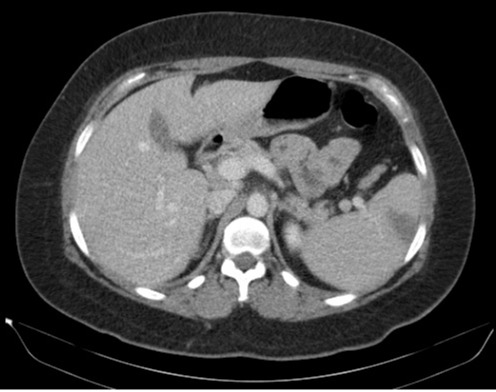Back


Poster Session D - Tuesday Morning
Category: Liver
D0552 - Cytomegalovirus-Associated Spontaneous Splenic Infarct in an Immunocompetent Patient
Tuesday, October 25, 2022
10:00 AM – 12:00 PM ET
Location: Crown Ballroom

Has Audio

Mohammad Darweesh, MD
East Tennessee State University
Johnson City, TN
Presenting Author(s)
Mohammad Darweesh, MD, Susan Kullab, MD, Suhib Fahmawi, MD, Lamis Ibrahim, MD
East Tennessee State University, Johnson City, TN
Introduction: Cytomegalovirus (CMV) associated thrombosis has been reported in medical literature and mainly in the immunocompromised population. However, CMV-associated splenic infarcts have rarely been reported.
Case Description/Methods: A 36-year-old Caucasian woman with no significant past medical history who presented to the emergency department with fever, chills, night sweats, palpitation, and mild abdominal pain was found to have acute CMV infection. The patient mentioned that she has used oral contraceptives prior to the presentation. No family history of thrombophilia has been reported. CT scan of the abdomen and pelvis showed a splenic infarct and an ultrasound of her spleen with doppler showed the same findings, i.e., splenic infarct with the normal flow in the splenic artery. However, Echocardiography showed no vegetation, PFO, or mural thrombus. Hypercoagulable workup was negative. Anticoagulation was deferred, oral contraceptives were stopped, and a copper IUD was recommended, patient was managed conservatively due to involvement of small vessels only and lack of related symptoms. She continued to do well on follow-up evaluations.
Discussion: Acute CMV infections with various thrombotic manifestations have been reported in the medical literature. It is a transient risk factor for both arterial and venous thromboembolism and can occur in immunocompetent patients in the absence of other hypercoagulable factors. The patient in our case had two risk factors that might explain the reason behind splenic infarction: the first, being on oral contraceptives and the second is the acute CMV infection. A meta-analysis on 97 patients in 2011 reported that the incidence of thrombosis among acute CMV infection in hospitalized patients was 6.4%, and the incidence of acute CMV infection among hospitalized patients with thrombosis was 1.9-9.1%. Several mechanisms have been described explaining the role of CMV in thrombosis. In vitro, CMV activates factor X and stimulates the production of factor VIII and vWF. It also binds to platelets via Toll-Like Receptor 2 and causes systemic endotheliitis at various sites in the body, leading to the expression of tissue factors. These mechanisms result in platelet and leukocyte aggregation, adhesion, and thrombin formation. In vivo, a transient increase in antiphospholipid antibodies and a decrease in protein C activation have been reported. In conclusion, patients with unexplained arterial or venous thrombosis should be tested for CMV infection as a possible etiology.

Disclosures:
Mohammad Darweesh, MD, Susan Kullab, MD, Suhib Fahmawi, MD, Lamis Ibrahim, MD. D0552 - Cytomegalovirus-Associated Spontaneous Splenic Infarct in an Immunocompetent Patient, ACG 2022 Annual Scientific Meeting Abstracts. Charlotte, NC: American College of Gastroenterology.
East Tennessee State University, Johnson City, TN
Introduction: Cytomegalovirus (CMV) associated thrombosis has been reported in medical literature and mainly in the immunocompromised population. However, CMV-associated splenic infarcts have rarely been reported.
Case Description/Methods: A 36-year-old Caucasian woman with no significant past medical history who presented to the emergency department with fever, chills, night sweats, palpitation, and mild abdominal pain was found to have acute CMV infection. The patient mentioned that she has used oral contraceptives prior to the presentation. No family history of thrombophilia has been reported. CT scan of the abdomen and pelvis showed a splenic infarct and an ultrasound of her spleen with doppler showed the same findings, i.e., splenic infarct with the normal flow in the splenic artery. However, Echocardiography showed no vegetation, PFO, or mural thrombus. Hypercoagulable workup was negative. Anticoagulation was deferred, oral contraceptives were stopped, and a copper IUD was recommended, patient was managed conservatively due to involvement of small vessels only and lack of related symptoms. She continued to do well on follow-up evaluations.
Discussion: Acute CMV infections with various thrombotic manifestations have been reported in the medical literature. It is a transient risk factor for both arterial and venous thromboembolism and can occur in immunocompetent patients in the absence of other hypercoagulable factors. The patient in our case had two risk factors that might explain the reason behind splenic infarction: the first, being on oral contraceptives and the second is the acute CMV infection. A meta-analysis on 97 patients in 2011 reported that the incidence of thrombosis among acute CMV infection in hospitalized patients was 6.4%, and the incidence of acute CMV infection among hospitalized patients with thrombosis was 1.9-9.1%. Several mechanisms have been described explaining the role of CMV in thrombosis. In vitro, CMV activates factor X and stimulates the production of factor VIII and vWF. It also binds to platelets via Toll-Like Receptor 2 and causes systemic endotheliitis at various sites in the body, leading to the expression of tissue factors. These mechanisms result in platelet and leukocyte aggregation, adhesion, and thrombin formation. In vivo, a transient increase in antiphospholipid antibodies and a decrease in protein C activation have been reported. In conclusion, patients with unexplained arterial or venous thrombosis should be tested for CMV infection as a possible etiology.

Figure: CT scan of the abdomen showing splenic infarction
Disclosures:
Mohammad Darweesh indicated no relevant financial relationships.
Susan Kullab indicated no relevant financial relationships.
Suhib Fahmawi indicated no relevant financial relationships.
Lamis Ibrahim indicated no relevant financial relationships.
Mohammad Darweesh, MD, Susan Kullab, MD, Suhib Fahmawi, MD, Lamis Ibrahim, MD. D0552 - Cytomegalovirus-Associated Spontaneous Splenic Infarct in an Immunocompetent Patient, ACG 2022 Annual Scientific Meeting Abstracts. Charlotte, NC: American College of Gastroenterology.
